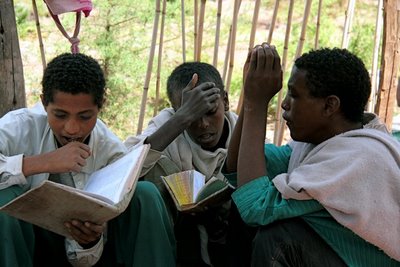Don’t we always live in two worlds at once? – Lalibela, Ethiopia
 Tuesday, June 30, 2009 at 2:21AM
Tuesday, June 30, 2009 at 2:21AM  The first world is deforested, and there is small cause for hope.
The first world is deforested, and there is small cause for hope.
 Priests are bored and vaguely resentful
Priests are bored and vaguely resentful
 …that they must lift up their church’s ancient cross for you -- in return for ten birr or so.
…that they must lift up their church’s ancient cross for you -- in return for ten birr or so.
 Sometimes no photographs of the second world seem possible at all.
Sometimes no photographs of the second world seem possible at all.
After all, a camera around your neck is different from a cross,
 ...but Debi's warmth can draw the second world up towards the surface anyway
...but Debi's warmth can draw the second world up towards the surface anyway
 ...because the second world we live in is always a relationship.
...because the second world we live in is always a relationship.
 This woman might have carried firewood for four hours
This woman might have carried firewood for four hours
 …of an utterly deforested land.
…of an utterly deforested land.
 In the second world, walking is as natural as grace,
In the second world, walking is as natural as grace,
 …and the scent of frankincense and smoke rises from the same firewood,
…and the scent of frankincense and smoke rises from the same firewood,
 …and the scent of the roasting beans rises, too,
…and the scent of the roasting beans rises, too,
 ...in a coffee ceremony meant entirely for you
...in a coffee ceremony meant entirely for you
 …when someone invites you into their home.
…when someone invites you into their home.
 In the first world, street kids lie to you.
In the first world, street kids lie to you.
 “I am a student,” the young boy says. “I want to be a lawyer. To end corrupt.”
“I am a student,” the young boy says. “I want to be a lawyer. To end corrupt.”
You know what he means. And he has learned well the rhetoric that someone like you would want to hear.
“My examination is in several days. But I don’t have pencils or books.”
 But in the first world, if you buy them for him, as soon as you round the corner, he returns them to the store, and in collusion with the shop owner turns a neat little profit, perhaps for ch’at or beer.
But in the first world, if you buy them for him, as soon as you round the corner, he returns them to the store, and in collusion with the shop owner turns a neat little profit, perhaps for ch’at or beer.
And he continues to learn that begging on the street brings more quick money to hand than long hours over those same books.
 In the second world, children go to school,
In the second world, children go to school,
 …perhaps even a traditional Ethiopian liturgical school,
…perhaps even a traditional Ethiopian liturgical school,
 …where many of the brightest students in Lalibela go.
…where many of the brightest students in Lalibela go.
 In the second world, peers read to a blind student – the young man on the right
In the second world, peers read to a blind student – the young man on the right
 …in the ancient Ethiopian language of Ge’ez,
…in the ancient Ethiopian language of Ge’ez,
 …and the young man learns the liturgical texts and songs by heart.
…and the young man learns the liturgical texts and songs by heart.
 In the first world, missionaries, even those of good intent, don’t critique deeply enough the cultural and political assumptions they still import.
In the first world, missionaries, even those of good intent, don’t critique deeply enough the cultural and political assumptions they still import.
 Perhaps the church still looks European
Perhaps the church still looks European
 …and they build compounds and empires, large and small, to protect themselves from a history they, and we, have helped create.
…and they build compounds and empires, large and small, to protect themselves from a history they, and we, have helped create.
Perhaps you recognize them. Perhaps you’ve lived in one of them yourself.
 In the second world, the church is indigenous.
In the second world, the church is indigenous.
 It has had its own relationship with Jerusalem and Alexandria -- and with the trade route through the Red Sea between Greece
It has had its own relationship with Jerusalem and Alexandria -- and with the trade route through the Red Sea between Greece
 That is to say, it has had a history of influences and engagement as has any land,
That is to say, it has had a history of influences and engagement as has any land,
 …but no one has painted its faith
…but no one has painted its faith
 …in the color of someone else’s face.
…in the color of someone else’s face.
 Rumi is one of the poets who has written of these two worlds -- for instance, in his poem “Tending Two Shops.”
Rumi is one of the poets who has written of these two worlds -- for instance, in his poem “Tending Two Shops.”
 “The only real rest comes
“The only real rest comes
when you’re alone with God,” he says.
 “Live in the nowhere you came from
“Live in the nowhere you came from
 “…even though you have an address here.
“…even though you have an address here.
 “You own two shops,
“You own two shops,
and you run back and forth.
 “Try to close the one that’s a fearful trap
“Try to close the one that’s a fearful trap
getting always smaller.
 “Checkmate this way,
“Checkmate this way,
checkmate that.
 “Keep open the shop
“Keep open the shop
where you’re not selling fishhooks any more.
 “You are the free-swimming fish.”
“You are the free-swimming fish.”
 So let’s go back a second time through the rock-hewn churches of Lalibella,
So let’s go back a second time through the rock-hewn churches of Lalibella,
 We’ll enter through the portal called Adam’s Tomb -- because we must pass through death
We’ll enter through the portal called Adam’s Tomb -- because we must pass through death
 …and never all the way apparent in any single glance,
…and never all the way apparent in any single glance,
 …no matter in which single place you stand at any given moment.
…no matter in which single place you stand at any given moment.
 Nonetheless, you’ve already been intuiting as you walk
Nonetheless, you’ve already been intuiting as you walk
 …that these rock-hewn churches of Lalibela,
…that these rock-hewn churches of Lalibela,
 …form some map of your own soul.
…form some map of your own soul.
 “Are you a Christian?” I am asked in this second world by a man with good English who, like me, is circling the Medhane Alem on the feast of the Redeemer,
“Are you a Christian?” I am asked in this second world by a man with good English who, like me, is circling the Medhane Alem on the feast of the Redeemer,
 …prayers beads through our fingers,
…prayers beads through our fingers,
 …small Ethiopian crosses around our necks.
…small Ethiopian crosses around our necks.
 In the second world, there is only understanding
In the second world, there is only understanding
 …and the beautiful cross of the church, which the priest is eager to show you now, has become even more beautiful still,
…and the beautiful cross of the church, which the priest is eager to show you now, has become even more beautiful still,
 …and in the second world, he sits
…and in the second world, he sits
 …and doorways all along the way,
…and doorways all along the way,
 …and in the second world, no door is really closed,
…and in the second world, no door is really closed,
 …and there are no dead-ends anywhere, no matter how things might first appear.
…and there are no dead-ends anywhere, no matter how things might first appear.
 Later, when all the churches have been closed, you cannot count the prostrations a young man makes at the doorway of the Biet Emmanuel far below you.
Later, when all the churches have been closed, you cannot count the prostrations a young man makes at the doorway of the Biet Emmanuel far below you.
 He thinks he is praying all alone,
He thinks he is praying all alone,
 …but in the second world, the unseen is always praying with you.
…but in the second world, the unseen is always praying with you.
 There have been crosses all along the way as well,
There have been crosses all along the way as well,
 …and yet each belongs exactly here.
…and yet each belongs exactly here.
 When you hear rock-hewn churches, you might think this just means they are made of stone.
When you hear rock-hewn churches, you might think this just means they are made of stone.
And sometimes this is partly true.
 But more often they are monolithic, or semi-monolithic. This means that they have been carved from one block of stone as a whole.
But more often they are monolithic, or semi-monolithic. This means that they have been carved from one block of stone as a whole.
 This means that a church like Biet Giorgis is not a fabricated building at all.
This means that a church like Biet Giorgis is not a fabricated building at all.
 Rather, Biet Giorgis is a sculpture,
Rather, Biet Giorgis is a sculpture,
 In the second world, all of us are pilgrims,
In the second world, all of us are pilgrims,
 …and when you emerge from an underworld like this,
…and when you emerge from an underworld like this,
 …back into a town that has never stopped surrounding you,
…back into a town that has never stopped surrounding you,
 …no matter how single you might have felt,
…no matter how single you might have felt,
 …you find friends passing and greeting and acknowledging one another all along the street,
…you find friends passing and greeting and acknowledging one another all along the street,
 …and since you do not press for eye contact long yourself,
…and since you do not press for eye contact long yourself,
 …friends greet and acknowledge you as well.
…friends greet and acknowledge you as well.
 There has been a funeral on this day, too,
There has been a funeral on this day, too,
 …down in the River Jordan that runs through the churches of Lalibela.
…down in the River Jordan that runs through the churches of Lalibela.
 It is called the River Jordan because the churches of Lalibela are understood to form an image of Jerusalem itself,
It is called the River Jordan because the churches of Lalibela are understood to form an image of Jerusalem itself,
 …and the journey which you just have made
…and the journey which you just have made
 …has been from an historical Jerusalem
…has been from an historical Jerusalem
 It will take you two more weeks to understand this -- without ever really understanding anything -- because at the same time that you were walking through the underworld of these churches,
It will take you two more weeks to understand this -- without ever really understanding anything -- because at the same time that you were walking through the underworld of these churches,
 …your dear friend Jeannine was making this journey in the most profound way of all,
…your dear friend Jeannine was making this journey in the most profound way of all,
 …so that only now do you understand that your own pilgrimage,
…so that only now do you understand that your own pilgrimage,
 …through the threshold of death
…through the threshold of death
























Reader Comments